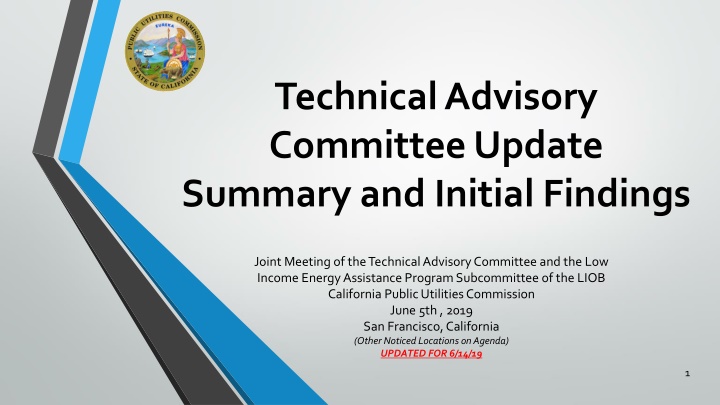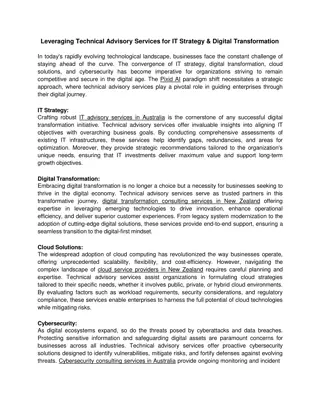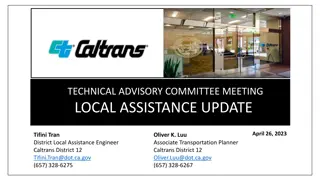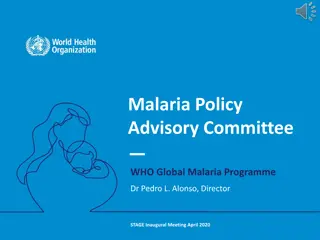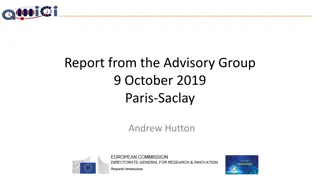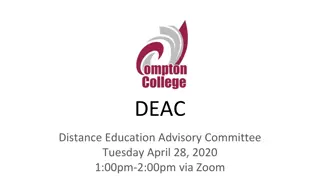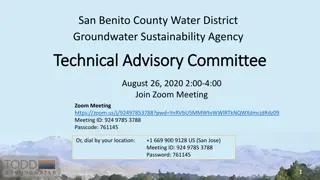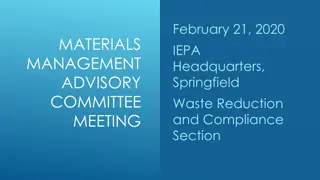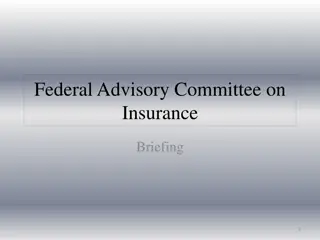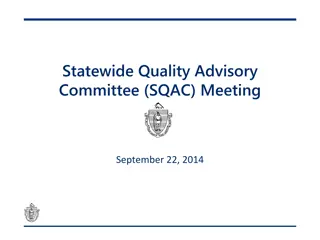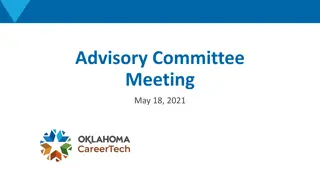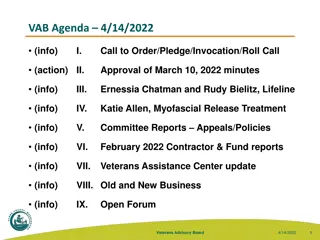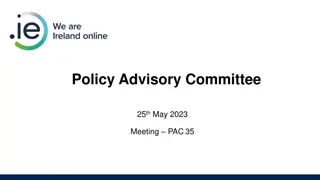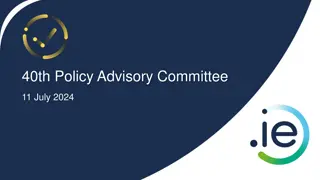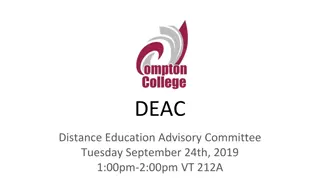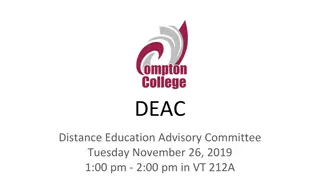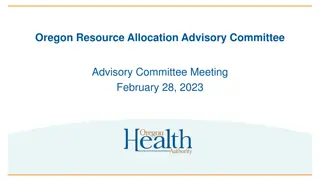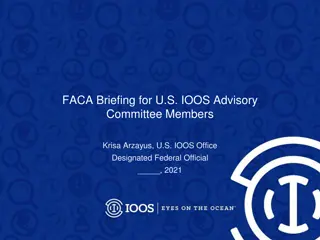Update on Technical Advisory Committee Meeting
Initial findings from the joint meeting of the Technical Advisory Committee and the Low Income Energy Assistance Program Subcommittee highlighted the potential benefits of leveraging government assistance programs for low-income rate payer initiatives. Preliminary data analysis revealed discrepancies in reported CARE eligibility versus actual enrollment, emphasizing the need for targeted outreach and improved data sharing. The project roadmap included analysis on AMI CARE data, disconnection rates, and insights on energy burden. Further exploration and validation of results are ongoing with contributions from key stakeholders.
Uploaded on Sep 06, 2024 | 5 Views
Download Presentation

Please find below an Image/Link to download the presentation.
The content on the website is provided AS IS for your information and personal use only. It may not be sold, licensed, or shared on other websites without obtaining consent from the author.If you encounter any issues during the download, it is possible that the publisher has removed the file from their server.
You are allowed to download the files provided on this website for personal or commercial use, subject to the condition that they are used lawfully. All files are the property of their respective owners.
The content on the website is provided AS IS for your information and personal use only. It may not be sold, licensed, or shared on other websites without obtaining consent from the author.
E N D
Presentation Transcript
Technical Advisory Committee Update Summary and Initial Findings Joint Meeting of the Technical Advisory Committee and the Low Income Energy Assistance Program Subcommittee of the LIOB California Public Utilities Commission June 5th , 2019 San Francisco, California (Other Noticed Locations on Agenda) UPDATED FOR 6/14/19 1
Acknowledgements and Key Reminders This is an initial overview and we are continuing to explore relationships, refine results and validate findings Special thanks to PG&E, SCE, SDG&E, SoCal Gas, CSD, CDSS, HUD, the Energy Division, and the Census Bureau for their contributions Another presentation is scheduled for the June 24, 2019 LIOB meeting that will incorporate this committee s feedback additional information 2
Technical Advisory Committee Background Study the potential benefits of leveraging government public assistance programs that already means test their enrollees as eligible for low-income rate payer programs such as CARE Preliminary results from unduplicated household categorical data from Contra Costa County indicated a potential discrepancy between reported CARE eligibility and actual CARE eligibility as defined by unduplicated household data quantifying enrollment in three of these programs Detailed analysis of unduplicated household categorical enrollment, CARE eligibility, CARE penetration rate and disconnections could enable targeted outreach and highlight benefits of agency data sharing 3
Project Roadmap Preliminary Analysis Analysis on AMI CARE Data 3 1 2 START Data exploration & understanding Calculated the AMI categories, based on that calculated eligible households Prepared CARE data as per the requirement Median Approach 200 % FPL 5 4 Finalized median based approach to Estimate households below 200% FPL Estimated households at and below 200% FPL line using different approaches Categorical Data Disconnection Data Overall Insights 7 8 6 Overall insights Analysis on energy burden & disconnection rate Compared CARE & Census data with categorical data Overall insights 4
Data Collection The follow data sets were used for the analysis: CARE enrollment by zip code CARE penetration rate by zip code CARE eligible households by zip code Utility disconnection data by zip code Single Metered Household Data by zip code (for Phase 2) Unduplicated enrollment by zip code for MediCal, CalFresh, and CalWORKs by household American Community Survey data from the Census Bureau Area Median Income data from Department of Housing and Urban Development (HUD) Other public assistance data will be collected for Phase 2 5
Methodology Overview An initial analysis showed substantial instances where household enrollment in public assistance programs at or below CARE eligibility requirements greatly exceeded the stated 100% CARE enrollment CARE eligibility was calculated using multiple statistical methods to ensure accuracy and validate results. American Community Survey (ACS) and Area Median Income (AMI) from the Census Bureau were the primary external data sources used in the various estimates. American Community Survey is an ongoing survey conducted by the census bureau that collects information about income, race, household language, housing characteristics and other key demographics. Area Median Income provides the midpoint of a region s or zip code s income distribution. Income thresholds are set relative to the area (30% of AMI, 50% of AMI or 80% of AMI) to identify households eligible for affordable housing. 6
CARE Eligibility Estimation Methodology All calculation methods utilized (IOU) CARE income guidelines to estimate the number of households eligible for CARE for each household size at the county and zip code levels. Methodologies outlined in the following slides were used to validate the AMI based CARE eligibility estimates. 7
CARE Eligibility Census Estimation Methodology (Part 1) Household Income Method 1: County & Zip code level available Using American Community Survey data from the Census Bureau: Calculate the number of households across the income range Calculate the share of household size based on proportion of income range. Household Income Average no of people per household = Total Households / Total population Geography Median income 0 - 30 K 30 - 40 K 40 - 50 K 50 - 60 K 60 - 70 K County 1 22835 20000 30000 25000 15000 65000 3.5 Household Median Income Method 2 : County & Zip code level available 7-or-more person household 1-person household 2-person household 3-person household 4-person household 5-person household 6-person household Geography Metric Name No. of Households Median Income 139,312 172,427 102,826 91,077 37,906 14,941 10,581 County 1 $ 42,253 $ 91,428 107,237 $ 124,858 $ 108,129 $ $ 109,612 $ 111,992 * The values and ranges mentioned are for representative purposes only 8
CARE Eligibility Census Estimation Methodology (Part 2) Using American Community Survey data from the Census Bureau: Distribute the households for each income bracket across household size Based on the CARE eligibility guidelines, calculate eligible households at and below 200% FPL * The values and ranges mentioned are for representative purposes only County level #1 : Alameda County Income upper limit by household size $ $ $ $ $ $ $ - Household Size Less than $30,000 $30,000 to $34,999 $35,000 to $39,999 $40,000 to $44,999 $45,000 to $49,999 $50,000 to $59,999 $60,000 to $74,999 $75,000 to $99,999 $100,000 or more factor 2 (modulus) Overall households below 200% FPL factor 1 base 1 2 3 4 5 6 54,657 25,949 9,623 7,301 4,010 1,097 953 103,590 7,360 5,029 2,125 1,884 988 596 352 18,334 6,566 4,262 2,788 1,732 982 775 316 17,421 4,973 5,610 2,733 1,756 1,005 370 275 16,722 Factor 1: No. of Households per Household income Factor 1 = Households in income bucket / Range of income bucket Factor 2: CARE Upper limit Min. value of Interested Income bucket Example: Factor 2 = 33,820 - 30,000 = 3,820 Base: Households below 200% FPL in CARE Upper limit income bucket Base = Factor 1 x Factor 2 5,985 4,498 2,590 1,954 931 631 473 17,061 11,304 9,370 5,135 3,717 2,087 940 711 33,265 12,235 13,942 7,153 7,047 3,638 1,576 805 46,396 17,956 18,901 11,908 9,466 5,370 2,575 1,573 67,750 50,828 64,586 48,590 50,662 19,522 9,498 4,846 248,531 33,820 33,820 42,660 51,500 60,340 69,180 78,020 - 1.47 1.01 0.55 0.37 0.24 0.11 0.06 3820 3820 2660 1500 340 4180 3020 - 5,624 3,843 1,454 558 62,017 29,793 15,990 15,184 10,086 4,848 4,075 141,993 82 439 190 7 or More Total - 9
Area Median Income Based Estimations Based on the area median income data from ACS (at household size level), households at 200% FPL or below were calculated. Sample calculation: Los Angeles poverty level estimation (for households of 2 persons) 10
Area Median Income Based Estimations Alameda County, California Households below Median income Total Care income Eligiblity limit Diff b/w median & eligiblity income(in %) Households b/w Median income & CARE eligiblity Households below 200% FPL Household size Median income households 1 2 3 4 5 6 139,312 172,427 102,826 91,077 37,906 14,941 10,581 $ $ $ $ $ $ $ 42,253 91,428 107,237 124,858 108,129 109,612 111,992 69,656 86,214 51,413 45,539 18,953 7,471 5,291 $ 33,820 $ 33,820 $ 42,660 $ 51,500 $ 60,340 $ 69,180 $ 78,020 19.96% 13,902 63.01% 54,322 60.22% 30,960 58.75% 26,755 44.20% 8,377 36.89% 2,756 30.33% 1,605 Total households below 200% FPL 55,754 31,891 20,453 18,783 10,576 4,715 3,686 145,858 7 or more Estimate the households between median income range and CARE eligibility limit. Calculate households below 200% FPL by excluding the estimated households from the households below median income. Repeated the same process and estimated the households below 200% FPL at the zip code level. 11
CARE Reported Eligibility vs Census Estimated Eligibility County Level Map 0-25% of zip codes had more households reported than CARE 25-50% of zip codes had more households reported than CARE 50-75% of zip codes had more households reported than CARE > 75% of zip codes had more households reported than CARE With the AMI approach (ACS Data) 4,294,797(17% > Reported CARE Eligible) households were estimated as below 200% FPL. In 36 counties the estimated eligible household count is greater than reported CARE eligible households. Next step will be to compare this finding with unduplicated public assistance data for the same counties and zip codes and adjust for other variables. Note: Households in the key above means the total count of households enrolled in one or more public assistance programs that automatically qualify a person for CARE 12
CARE Reported Eligibility vs Census Estimated Eligibility Zip Code Level Geo-Spatial Map Reported CARE Eligible households lower than AMI estimated CARE eligible households Reported CARE Eligible households higher than AMI estimated CARE eligible households 13
CARE IOU Reported Eligibility vs Census Estimated Eligibility Key Findings There are 899 zip codes where the total number of households reported as eligible for CARE are less than the AMI estimated eligible household count. In 66% of urban counties, the total number of households reported as eligible for CARE is lower than AMI estimated number of eligible households. In 33% Rural Counties, the total number of households reported as eligible for CARE is lower than AMI estimated number of eligible households. There are 609 zip codes where the total number of households reported as eligible for CARE is greater than AMI estimated number of eligible households. 14
*CARE Enrollment and Public Assistance Enrollment Comparative Analysis An analysis of unduplicated household enrollment for CalFresh, CalWORKs, MediCal and Tribal TANF compared to reported CARE enrollment (zip code). This bar graph shows a breakdown of service by proportion of 100% percent eligibility in the CARE program by each IOU for each county 15
CARE Enrollment and Public Assistance Enrollment Key Findings Unduplicated Categorical enrollment is higher than CARE enrollment Unduplicated Categorical enrollment is lower than CARE enrollment In 1,059 Zip codes (62%), public assistance household enrollment is higher than CARE enrolled households often well above the stated 100% CARE penetration rate. **This suggests the potential benefits of leveraging public assistance program for CARE outreach. Additional datasets from public assistance programs will be incorporated in phase 2. 16
Reported CARE Eligibility and Public Assistance Enrollment Findings For Compton Difference between Unduplicated Public Assistance vs Reported CARE eligibility Unduplicated Public Assistance Household Enrollment Data Reported CARE eligibility Zip Cod 90220 90221 90222 Total 15,470 25,400 9,761 50,631 6,062 6,157 4,007 16,226 9,408 19,243 5,754 40,631 Note: Zip Codes Serviced by SCE and SCG 17
Energy Burden Observations For Low Median Income Households (LMI) LMI Households: Households with less than 80% of Area Median Income Non-LMI Households: Households with More than 80% of Area Median Income Many rural areas have a higher energy burden (10%) compare to Sub urban (5%) and Urban areas (3%) 18
Energy Burden Observations For Low Median Income Households (LMI) Avg. Dollars Spend on Electricity (LMI Households) NOTE: LMI Households are households with less than 80% of Area Median Income, which is the income level used for for comparison PLACEHOLDER CHART 80% Median income Left out Counties 19
Preliminary Recommendations Ask LIOB to utilize mapping and reporting at the zip code level to inform the LIOB on program performance for CARE (and potentially ESA) Formally request the IOUs to identify any challenges to conducting CARE outreach in partnership with County agencies - including: Directly contracting for outreach for a fixed fee vs per enrollee Focusing on zip codes and counties that show the greatest difference in CARE enrollment and households enrolled in qualifying public assistance programs Consider additional findings at the 6/24/19 meeting to take further action 20
Next Steps Gather all feedback from Committee Members and other stakeholders Combine existing unduplicated household dataset of public assistance programs with additional public assistance data from other agencies Additional analysis and validation measures 21
